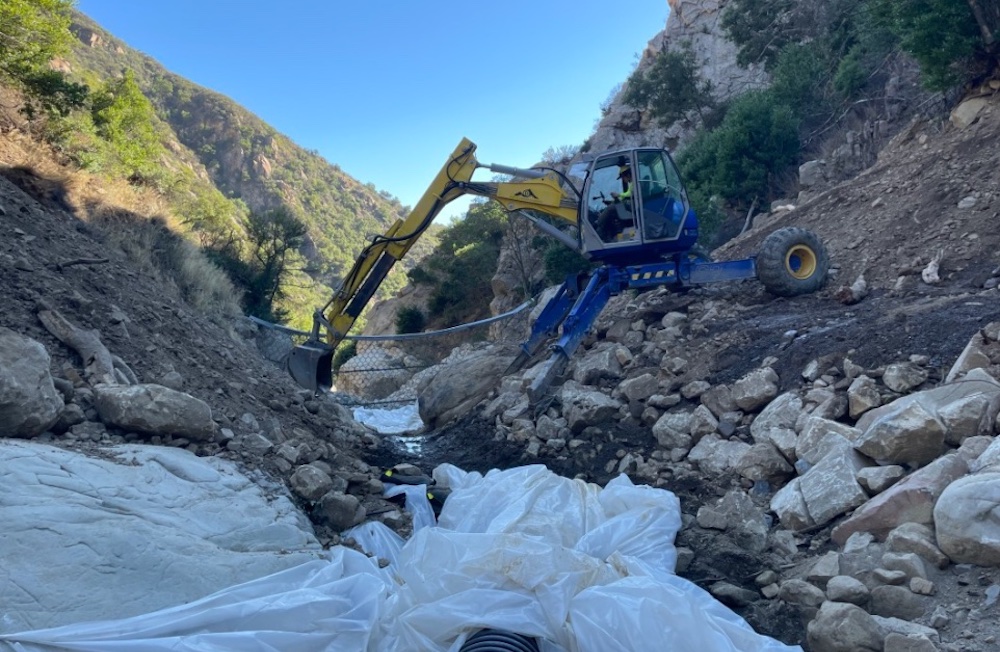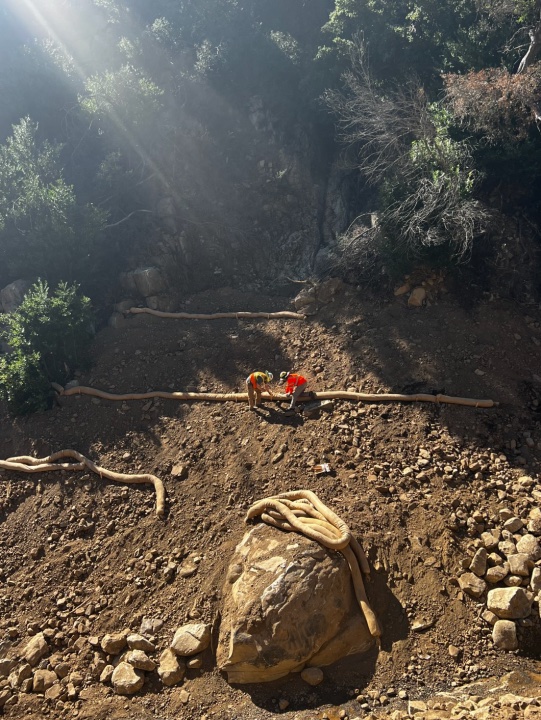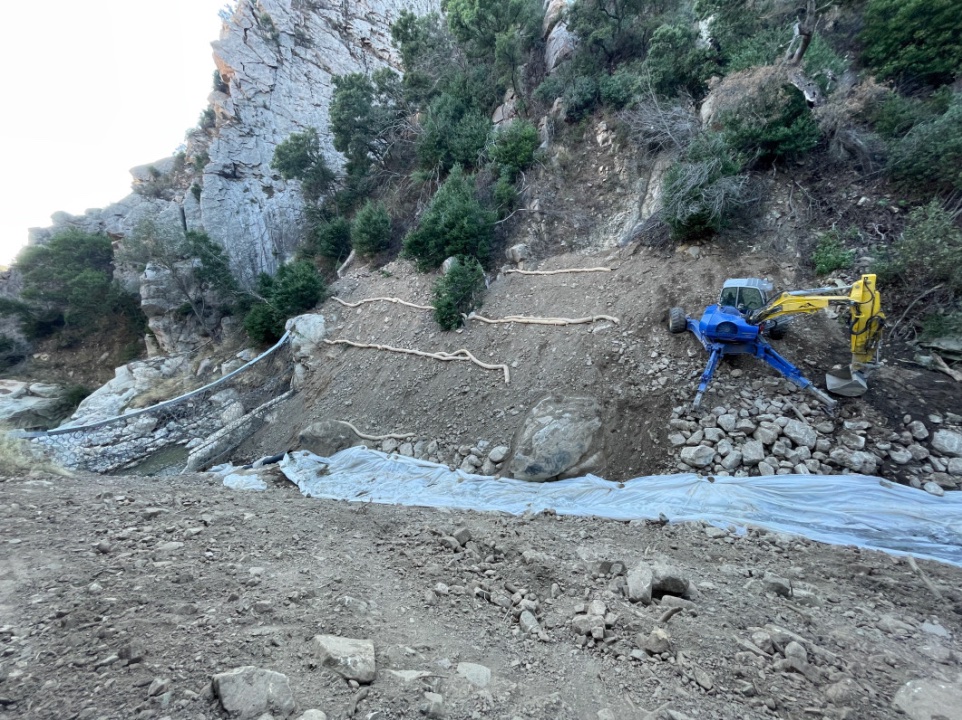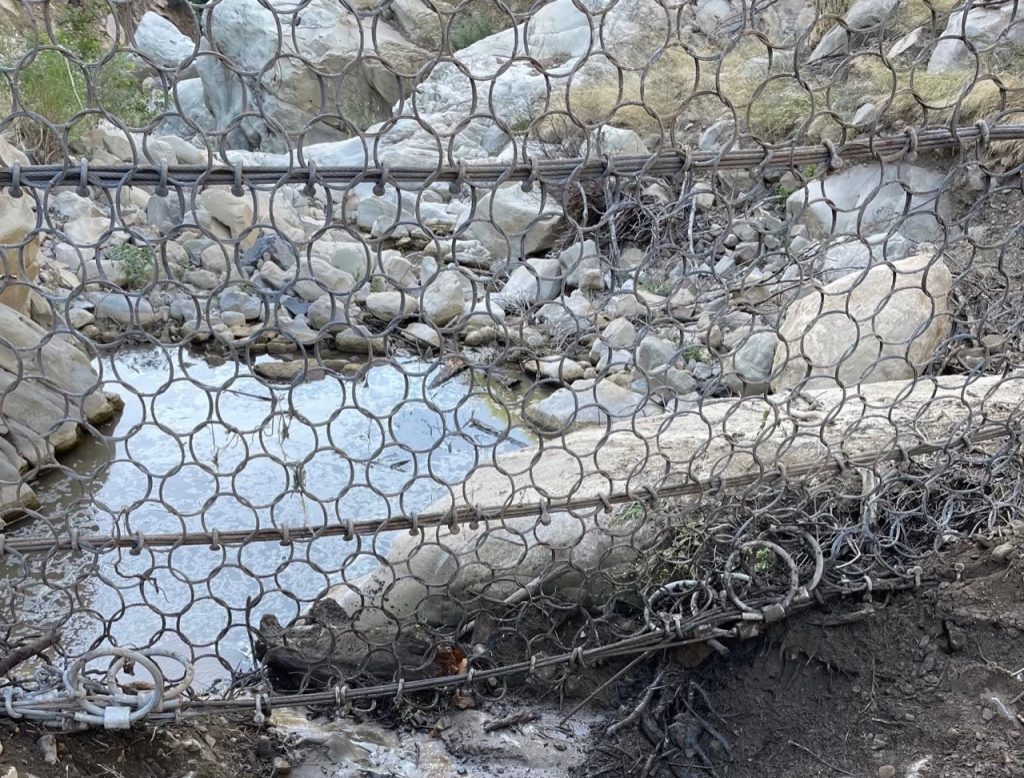Debris Nets Cleaned and Ready for County Decision

Dear TPRC Supporters,
I want to update you on “the Nets” and our progress, and challenges, as we rapidly approach the termination of our five-year emergency permits on December 21. We have given the county a deadline of next week to commit to the nets becoming a permanent part of the Flood Control System.
First, I am happy to report that the clean out of our net in San Ysidro Canyon is complete.

– The work began on October 5 with our crews, biologists, hydrologists, archeologist, and Native American observers carefully and rigorously adhering to the terms of our Fish and Wildlife permits.
– The net has been emptied, with great care taken to abide by the conditions of our permit in the Environmentally Sensitive Habitat (ESH) and water is flowing down the channel.
– The net clean out went quicker and better than expected, providing a blueprint for any future net clean out (see photo).
– Helicopters were used to move only our equipment into the work area. There has been a false perception that we were moving the debris with the helicopters. That is incorrect.
– Our plan, approved by all the regulatory agencies, involved redistributing the debris within the channel and restoring its banks to allow the material to be placed in a way that allows it to travel downstream to the shore as it would naturally to restore our beaches, which eliminates the need to truck this material to Goleta Beach or other areas with hundreds of trucks traveling through Montecito.
– Our biologists from Storrer Environmental made daily reports on impacts or sightings of birds, mammals, amphibians, and vegetation in the project area. A fish survey showed that there were no endangered steelhead trout in the stream between the San Ysidro Debris Basin and our net.
Second, among our critical milestones, we have a scheduled vote on November 15 by the Montecito Planning Commission to extend the five-year permits.
– Because we have exceptionally completed the required applications and monthly reports on the efficacy of the nets, and have qualified for FEMA reimbursement, the extension should be routine, and is urgently needed before the permits expire on December 22. (What took TPRC nine months to get permits from five different agencies should not be needed if the nets are within County jurisdiction.)

Third, and most important, is TPRC’s five-year goal to reach an agreement with the County to take over responsibility of the net system.
– This six-million-dollar debris flow protection system of six nets paid for by over 1,000 community residents should become part of the Flood Control District of Santa Barbara County.
– The benefits of the nets remaining in place are many.
– The 1/9/2018 debris flow was one of the largest disaster events in Santa Barbara County history. We lost 23 of our family, friends, and neighbors, with hundreds other others injured and traumatized. 527 homes were destroyed or damaged and 28 businesses and U.S. 101 were closed for weeks. The loss of property tax revenue due to the $1.2 billion loss in property value put a dent in the County budget in the tens of millions.
– It is also in the economic interest of the County to support the Net Mitigation System. Montecito provides nine percent of the property taxes to the County with only three percent of the residences in the county. The Net System and augmenting the debris basins can help protect not only lives, but also the $186,000,000 in property taxes paid by Montecito residents that help to serve the overall County Budget.
– The question should never be debris basins or debris nets, but both working in tandem to provide a more robust debris retention program.
For five years, TPRC has provided the County with countless reports of geotechnical and biological assessments of the nets’ proven efficacy and value, provided by world-class engineering firms.

TPRC has laid out a proposal to the County that the TPRC board will remain in place, as well as the design contractors and world-class engineering firms, all with ample insurance and general liability policies, from which the County is already protected by, through 2029. The landowners upon which the nets sit have also committed their land for the protective nets. The useful life of the nets exceeds 50 years.
The extension of the permits and the County accepting the nets as part of the mitigation system was always paramount.
The nets have been vetted around the world as a proven mitigation system and part of an overall system to stop momentum and volume of potential debris flows. They are a sound approach, if not a crucial model, for preparedness and risk management. In the event of another, and likely, catastrophic debris flow or extreme disaster, the potential to save lives and mitigate property damage is reinforced with the nets intact in our California canyons.
A decision is needed. TPRC requires a Go/No Go decision from the County for this proposal by October 30, 2023. We simply cannot wait any longer.
Public-private partnerships play a key role in community improvement, but a small nonprofit organization, relying entirely on community contributions, cannot sustain them alone. We feel that the “private” part of this public-private endeavor has given more than enough.
We can and must efficiently transfer these important community assets to local, state, or regional authorities, where they should have been from the outset. It is far past time for the County to carry its fair share of the load.
As always, thank you for your steadfast support, and for the hundreds of letters many of you wrote in support of the nets to the Supervisors. They do help! Don’t hesitate to call them or me with any questions.
Pat McElroy, Executive Director
The Project for Resilient Communities
The MJ reached out to Das Williams for a statement. He replied: “They have a Planning Commission hearing for permit extensions on Nov 15th, and our Planning Department has already agreed to meanwhile give them more time. I still have hope we could come to an agreement on terms with alacrity, but the endowment needs to be enough that we would not be endangering other flood control projects, including others in Montecito. Through our Master Plan, we could increase the capacity of the Montecito watersheds to 100 years, but would be challenged to make those changes if we undertook additional financial commitments alone.”







